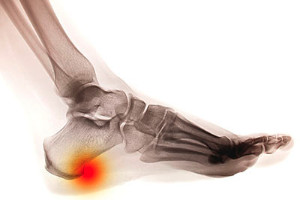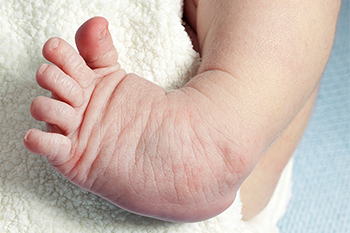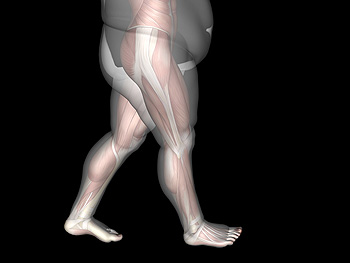Connect With Us
Blog
Items filtered by date: April 2024
Clarifying Misconceptions of Cuboid Syndrome

Cuboid syndrome is a lesser-known condition that affects the cuboid bone, one of the seven tarsal bones located in the midfoot. This syndrome occurs when the ligaments surrounding the cuboid bone become strained or injured, leading to pain and discomfort along the outer side of the foot. Cuboid syndrome is often misunderstood or misdiagnosed, due to its symptoms overlapping with other foot ailments such as ankle sprains or stress fractures. The characteristic symptoms of cuboid syndrome include pain, tenderness, and swelling on the lateral aspect of the foot, particularly during weight-bearing activities like walking or running. The pain may also worsen with certain movements, such as pushing off the ground or standing on tiptoes. Understanding the distinct features of cuboid syndrome and its diagnostic criteria are essential for accurate identification and appropriate management. If you have pain in the outside part of your foot, it is suggested that you promptly schedule an appointment with a podiatrist for an exam, a diagnosis, and suggested treatment options.
Cuboid syndrome, also known as cuboid subluxation, occurs when the joints and ligaments near the cuboid bone in the foot become torn. If you have cuboid syndrome, consult with one of our podiatrists from Crosstown Podiatry. Our doctors will assess your condition and provide you with quality foot and ankle treatment.
Cuboid syndrome is a common cause of lateral foot pain, which is pain on the outside of the foot. The condition may happen suddenly due to an ankle sprain, or it may develop slowly overtime from repetitive tension through the bone and surrounding structures.
Causes
The most common causes of cuboid syndrome include:
- Injury – The most common cause of this ailment is an ankle sprain.
- Repetitive Strain – Tension placed through the peroneus longus muscle from repetitive activities such as jumping and running may cause excessive traction on the bone causing it to sublux.
- Altered Foot Biomechanics – Most people suffering from cuboid subluxation have flat feet.
Symptoms
A common symptom of cuboid syndrome is pain along the outside of the foot which can be felt in the ankle and toes. This pain may create walking difficulties and may cause those with the condition to walk with a limp.
Diagnosis
Diagnosis of cuboid syndrome is often difficult, and it is often misdiagnosed. X-rays, MRIs and CT scans often fail to properly show the cuboid subluxation. Although there isn’t a specific test used to diagnose cuboid syndrome, your podiatrist will usually check if pain is felt while pressing firmly on the cuboid bone of your foot.
Treatment
Just as the range of causes varies widely, so do treatments. Some more common treatments are ice therapy, rest, exercise, taping, and orthotics.
If you have any questions, please feel free to contact our offices located in Wayne, Montclair, and Randolph, NJ . We offer the newest diagnostic and treatment technologies for all your foot care needs.
Definition and Symptoms of Heel Spurs

Calcaneal spurs, also known as heel spurs, are bony protrusions that form on the underside of the heel bone, which is the calcaneus. These spurs develop in response to long-term inflammation and tension on the plantar fascia, a band of tissue that connects the heel bone to the toes. The repetitive stress and strain can lead to the formation of calcium deposits, resulting in the development of bony growth. Individuals with calcaneal spurs often experience symptoms such as sharp pain in the heel, particularly during weight-bearing activities like walking or standing. The pain may intensify with the first steps in the morning or after prolonged periods of rest. Additionally, tenderness and swelling around the affected area are common. While some people with calcaneal spurs may not experience any symptoms, others may find the pain debilitating, impacting their daily activities. If you have heel pain, it is strongly suggested that you visit a podiatrist who can accurately diagnose and treat heel spurs.
Heel spurs can be incredibly painful and sometimes may make you unable to participate in physical activities. To get medical care for your heel spurs, contact one of our podiatrists from Crosstown Podiatry. Our doctors will do everything possible to treat your condition.
Heels Spurs
Heel spurs are formed by calcium deposits on the back of the foot where the heel is. This can also be caused by small fragments of bone breaking off one section of the foot, attaching onto the back of the foot. Heel spurs can also be bone growth on the back of the foot and may grow in the direction of the arch of the foot.
Older individuals usually suffer from heel spurs and pain sometimes intensifies with age. One of the main condition's spurs are related to is plantar fasciitis.
Pain
The pain associated with spurs is often because of weight placed on the feet. When someone is walking, their entire weight is concentrated on the feet. Bone spurs then have the tendency to affect other bones and tissues around the foot. As the pain continues, the feet will become tender and sensitive over time.
Treatments
There are many ways to treat heel spurs. If one is suffering from heel spurs in conjunction with pain, there are several methods for healing. Medication, surgery, and herbal care are some options.
If you have any questions feel free to contact our offices located in Wayne, Montclair, and Randolph, NJ . We offer the latest in diagnostic and treatment technology to meet your needs.
Causes and Definition of Clubfoot

Clubfoot, a congenital deformity, occurs when the foot is twisted inward and downward, making it difficult to walk normally. This condition affects approximately one in every 1,000 births and can vary in severity. While the exact cause of clubfoot remains unknown, it is believed to result from a combination of genetic and environmental factors. Research suggests that certain genetic mutations may predispose individuals to clubfoot, while maternal smoking and nutritional deficiencies during pregnancy may increase the risk. Clubfoot can also occur as part of a syndrome involving other birth defects. Without treatment, clubfoot can lead to long-term mobility issues and discomfort. However, with early intervention, the majority of cases can be successfully corrected. Treatment typically involves a series of gentle manipulations and casting of the foot, followed by bracing to maintain the corrected position. In some cases, surgical intervention may be necessary to release tight tendons and ligaments. Early detection and prompt treatment are key to achieving optimal outcomes for individuals born with clubfoot. If your child has been born with this foot condition, it is suggested that you visit a podiatrist who can custom-tailor a correct treatment plan.
Congenital foot problems require immediate attention to avoid future complications. If you have any concerns, contact one of our podiatrists of Crosstown Podiatry. Our doctors can provide the care you need to keep you pain-free and on your feet.
Congenital foot problems are deformities affecting the feet, toes, and/or ankles that children are born with. Some of these conditions have a genetic cause while others just happen. Some specific foot ailments that children may be born with include clubfeet, polydactyly/macrodactyly, and cleft foot. There are several other foot anomalies that can occur congenitally. What all of these conditions have in common is that a child may experience difficulty walking or performing everyday activities, as well as trouble finding footwear that fits their foot deformity. Some of these conditions are more serious than others. Consulting with a podiatrist as early as possible will help in properly diagnosing a child’s foot condition while getting the necessary treatment underway.
What are Causes of Congenital Foot Problem?
A congenital foot problem is one that happens to a child at birth. These conditions can be caused by a genetic predisposition, developmental or positional abnormalities during gestation, or with no known cause.
What are Symptoms of Congenital Foot Problems?
Symptoms vary by the congenital condition. Symptoms may consist of the following:
- Clubfoot, where tendons are shortened, bones are shaped differently, and the Achilles tendon is tight, causing the foot to point in and down. It is also possible for the soles of the feet to face each other.
- Polydactyly, which usually consists of a nubbin or small lump of tissue without a bone, a toe that is partially formed but has no joints, or an extra toe.
- Vertical talus, where the talus bone forms in the wrong position causing other bones in the foot to line up improperly, the front of the foot to point up, and the bottom of the foot to stiffen, with no arch, and to curve out.
- Tarsal coalition, when there is an abnormal connection of two or more bones in the foot leading to severe, rigid flatfoot.
- Cleft foot, where there are missing toes, a V-shaped cleft, and other anatomical differences.
- Macrodactyly, when the toes are abnormally large due to overgrowth of the underlying bone or soft tissue.
Treatment and Prevention
While there is nothing one can do to prevent congenital foot problems, raising awareness and receiving neonatal screenings are important. Early detection by taking your child to a podiatrist leads to the best outcome possible.
If you have any questions please feel free to contact our offices located in Wayne, Montclair, and Randolph, NJ . We offer the newest diagnostic tools and technology to treat your foot and ankle needs.
The Impact of Obesity on Adult Foot Structure

Obesity, a prevalent health concern worldwide, exerts a profound influence on foot structure and function in adults. The increased body weight places excessive pressure on the feet, altering their biomechanics and leading to various structural changes. One notable effect is the flattening of the arches, known as pes planus or flat feet, due to the increased load-bearing capacity required to support the body. This condition can contribute to foot pain, fatigue, and discomfort while walking or standing for prolonged periods. Additionally, obesity may worsen existing foot conditions such as bunions, hammertoes, and plantar fasciitis, further compromising foot health and mobility. Furthermore, the accumulation of fat tissue in the feet can result in swelling, inflammation, and decreased flexibility. Addressing obesity through lifestyle modifications, including diet, exercise, and weight management, is essential for mitigating these structural changes and alleviating associated foot problems. If you are experiencing any type of foot pain due to excess weight, it is suggested that you schedule an appointment with a podiatrist.
The more you weigh, the harder your feet must work to support your body. If you’re an obese individual and are concerned about your feet, contact one of our podiatrists from Crosstown Podiatry. Our doctors can provide the care you need to keep you pain-free and on your feet.
Obesity and Your Feet
People who are overweight are putting more pressure on their ankles, knees, and hips as well as their feet. This unfortunately can lead to variety of different issues.
Problems & Complications Stemming from Obesity
- When the body is overweight, it tries to compensate by changing the way that it moves. An obese person may lean forward and put extra weight on the wrong part of the foot. This puts unnecessary stress on the feet.
- Obese people are also more likely to develop type II diabetes which is a condition that causes a lot of foot problems. People with diabetes often don’t feel the cuts and sores that they may have on their feet, which can lead to more complicated and severe issues.
- Plantar fasciitis is another foot condition that can be caused by obesity. Plantar fasciitis is an inflammation of the tissue along the bottom of the foot, which causes pain and stiffness while walking and climbing stairs.
If you have any questions, please feel free to contact our offices located in Wayne, Montclair, and Randolph, NJ . We offer the newest diagnostic and treatment technologies for all your foot care needs.
Do You Suffer From Painful Feet?
What is Plantar Fasciitis?

Plantar fasciitis is a prevalent foot condition characterized by inflammation of the plantar fascia, a thick band of tissue that runs across the bottom of the foot, connecting the heel bone to the toes. The primary cause of plantar fasciitis is the excessive or repetitive strain on the ligament, leading to tiny tears and inflammation. This strain can result from various factors, including prolonged standing or walking, wearing improper footwear, engaging in high-impact activities like running or jumping, and certain biomechanical issues such as flat feet or high arches. A common symptom of plantar fasciitis is heel pain, particularly when taking the first steps after waking up or after long periods of rest. This pain may gradually subside with movement but can worsen throughout the day with prolonged activity. Additionally, individuals with plantar fasciitis may experience stiffness and tenderness on the bottom of the foot, particularly near the heel. If you have heel pain, it is strongly suggested that you consult a podiatrist who can accurately diagnose and treat plantar fasciitis.
Plantar fasciitis can be very painful and inconvenient. If you are experiencing heel pain or symptoms of plantar fasciitis, contact one of our podiatrists from Crosstown Podiatry. Our doctors can provide the care you need to keep you pain-free and on your feet.
What Is Plantar Fasciitis?
Plantar fasciitis is the inflammation of the thick band of tissue that runs along the bottom of your foot, known as the plantar fascia, and causes mild to severe heel pain.
What Causes Plantar Fasciitis?
- Excessive running
- Non-supportive shoes
- Overpronation
- Repeated stretching and tearing of the plantar fascia
How Can It Be Treated?
- Conservative measures – anti-inflammatories, ice packs, stretching exercises, physical therapy, orthotic devices
- Shockwave therapy – sound waves are sent to the affected area to facilitate healing and are usually used for chronic cases of plantar fasciitis
- Surgery – usually only used as a last resort when all else fails. The plantar fascia can be surgically detached from the heel
While very treatable, plantar fasciitis is definitely not something that should be ignored. Especially in severe cases, speaking to your doctor right away is highly recommended to avoid complications and severe heel pain. Your podiatrist can work with you to provide the appropriate treatment options tailored to your condition.
If you have any questions please feel free to contact our offices located in Wayne, Montclair, and Randolph, NJ . We offer the newest diagnostic and treatment technologies for all your foot and ankle needs.

